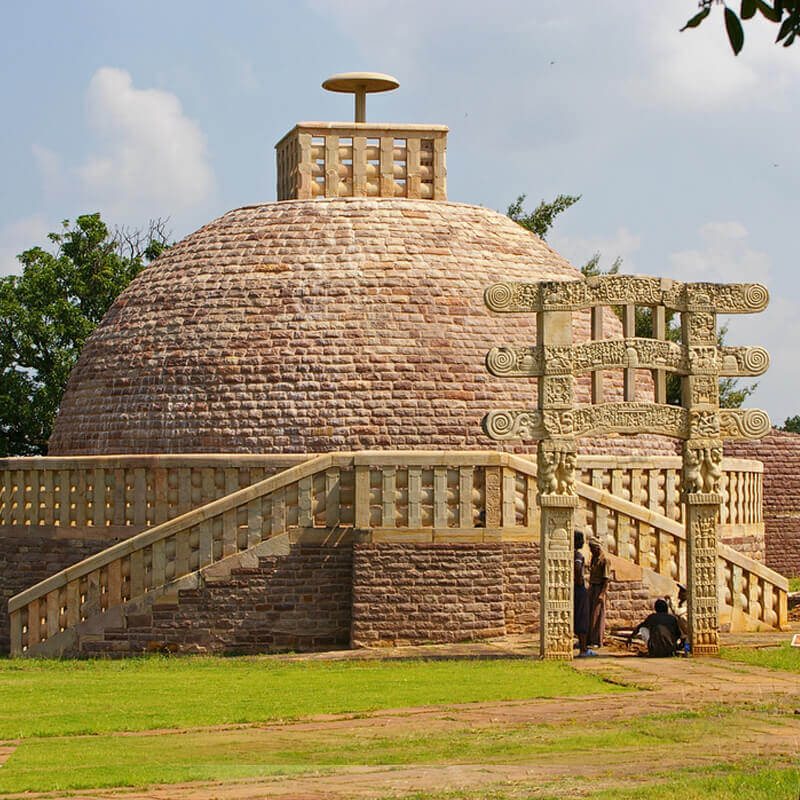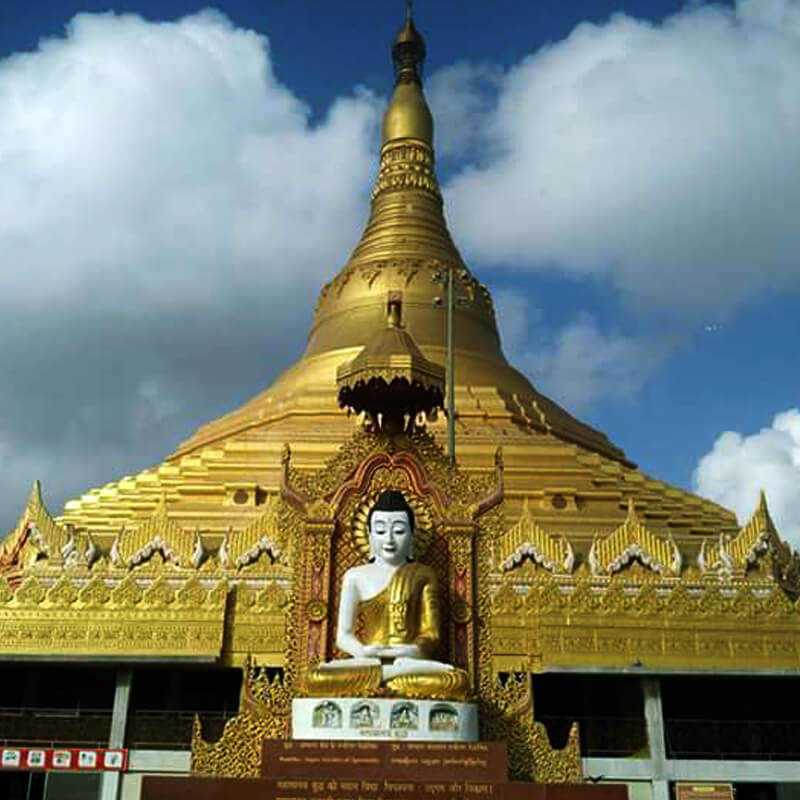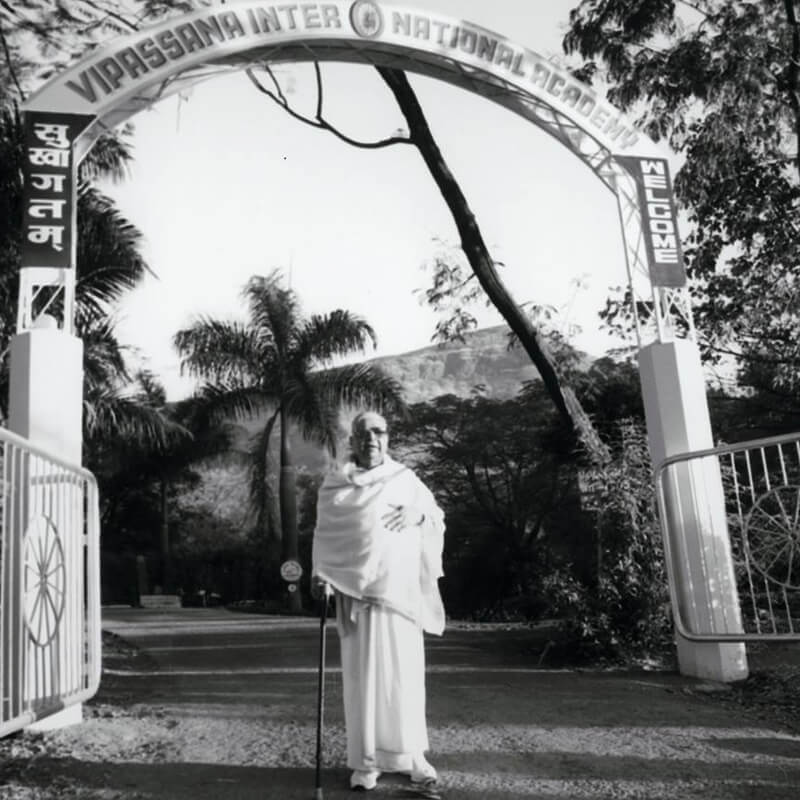Goenkaji and Mataji visited Thailand from 25 June to 4 July, 2001. The highlights of his tour were his Dhamma discourse at the Chulalongkorn University, his meeting with the scholars of the M. L. Maniratana Bunnag Dhamma Society Fund and his visit to Dhamma Ābhā, Phisanulok.
The Dhamma Society Fund (MDS) under the patronage of H. H. the Supreme Patriarch of Thailand is going to publish an international edition of the Tipiṭaka in Roman script. MDS Roman edition is based on the text of the Chaṭṭha Saṇgayana CD-ROM of Vipassana Research Institute, which in turn is based on the Chaṭṭha Saṇgāyana edition in Myanmar script. In Bangkok, Goenkaji visited the International Tipiṭaka Hall in the Chulalongkorn University on 26 June and met with the eminent Pāli scholars of MDS in Chulalongkorn University. He was informed about their efforts to bring out a flawless edition of the Chaṭṭha Saṇgāyana text in Roman text. Goenkaji gave them his best wishes for their editorial efforts. Goenkaji also said that the efforts of the MDS scholars would help VRI in the next version of its Chaṭṭha Saṇgāyana CD-ROM.
On 28 June, he was invited by the Dhamma Society Fund and the Chulalongkorn University to give a Dhamma talk that was presided over by H. R. H. Princess Galyani Vadhana of Thailand. This was telecast live worldwide on the global channel of TV 5. The subject of his Dhamma talk was "Vipassana Meditation and Tipiṭaka". In the talk Goenkaji narrated his own experience while explaining how benefits of the practice of Vipassana attracted him to Tipiṭaka (the words of the Buddha) and how the Tipiṭaka, in turn, inspired him. The Tipiṭaka clarified why he was asked to practise in this way by his teacher Sayagyi U Ba Khin. He narrated the experience of his first ten-day course:
I was also asked to keep my attention steadfastly fixed to the area at the entrance of the nostrils parimukhaṃ satiṃ upaṭṭhapetvā, that is, nāsikagge and the middle part of the upper lip uttaroṭṭhassa majjhimappadesa. I tried to keep my attention at this small area with the awareness of natural respiration at a stretch as long as possible. I understood the reason behind this technique a little later. In a day or two, the breath started becoming shorter and shorter, subtler and subtler, finer and finer. I came to know that if the area of concentration is small, the object of concentration is subtle and the continuity of the awareness is maintained uninterrupted for some time, the mind naturally becomes sharper and sharper and more and more sensitive. It starts feeling some sensation (vedanā) or the other on this small part of the body. This started happening on the second and the third day.
From the fourth day onwards when the meditation technique was switched to Vipassana, I was amazed to feel sensations throughout the body from the top of the head to the tips of the toes. With every sensation I could realise the nature of arising and passing away, which was bhāvanā-mayā paññā, to experience the nature of anicca. At the devotional level or the intellectual level it would have been merely suta-mayā paññā and cintā-mayā paññā, which according to my teacher cannot take us to the final goal of liberation. The Buddha gives importance to bhāvanā-mayā paññā, which was totally missing in my previous meditational practices. And now I understand that feeling of sensation on the body is the crux of the meditational teachings of the Buddha.
In my Hindu tradition I was quite confident that one should not indulge in sensual objects. I was taught not to react with craving or aversion when I came in contact with any sensual object, pleasant or unpleasant. The great discovery of the Buddha was that at the apparent level it seems that one is reacting to the sensual objects. But at the actual level, one is reacting to the body sensations. That is why in Paṭicca samuppāda, the Buddha did not say saḷāyatana paccayā taṇhā but he made the natural process very clear saying that saḷāyatana paccayā phasso, phassa paccayā vedanā, and vedanā paccayā taṇhā. So the craving for acquiring the pleasant and the craving for getting rid of the unpleasant is because of the sensations that one experiences on the body. This made me understand very clearly that the scientific discovery of the Buddha took me to the root of all the problems by developing the faculty to feel the different sensations on the body and not to react. Understanding that every sensation, pleasant, unpleasant or neutral has the same characteristic of anicca or udayabbaya, arising and passing away. I was greatly impressed by the teaching of the Enlightened One when I found that it is not merely an intellectual game or acceptance by blind devotion. I found that the Buddha was interested in understanding the Truth at the experiential level. Although suta-mayā paññā and cintā-mayā paññā have their own importance to give us inspiration and guidance, but actually, it is the bhāvanā-mayā paññā that gives the result of changing the unwholesome behaviour pattern of the mind at the root level.
As I continued to practise, it became clearer and clearer to me that the body sensation plays a very important role to take us on the path of misery. And the same body sensation helps us to proceed on the path of liberation. The sensations are always there so long as one is alive but when one remains ignorant, one keeps on reacting to the sensations by generating craving and aversion. With Vipassana, the scientific teaching of the Enlightened One, one develops the faculty of sati, that is awareness of the sensations and at the same time sampajaññaṃ, the paññā of the impermanent nature of the sensations. Atāpī sampajāno satimā. These two faculties help the meditator to come out of the unwholesome blind reactions to the sensations generating craving and aversion, lobha and dosa.
If the Buddha's teaching urged me only to abstain from lobha and dosa towards sensual objects, certainly it would not have attracted me because that was already present in my traditional teaching. But when I was asked to abstain from lobha and dosa pertaining to the body sensations, it became so clear that I was now working with anusaya kilesa, the impurities stored at the depth of the mind strengthening the unwholesome behaviour pattern at the root level. It was very clear to me that there are many methods of meditation which help one to purify the paritta citta, the surface of the mind but they do not deal with the anusaya, the deepest level of the so called unconscious mind, the root cause of generating and multiplying the habit pattern of mental impurities.
After explaining how Vipassana is spreading round the world among all classes, religions, regions of the world, Goenkaji added:
Thus, observing sensations equanimously as taught by the Buddha has proved to be a panacea, a universal remedy for all the miseries. Buddha's words are so clear in this respect when he says, vedanā samosaraṇā sabbe dhammā, everything that arises in the mind starts flowing with the sensation on the body. Therefore sensation plays such an important part in generating misery for us when we remain ignorant of the sensations and keep on reacting with lobha and dosa and so also the body sensations play a very important role when we remain aware of the sensations and don't react with lobha and dosa however pleasant or unpleasant they may be.
This helps every one to realise the universal truth of Anicca at the experiential level within the framework of the body. Observing the sensation without generating lobha and dosa gives the same result of purification of the mind to any one who practises it. That is why the technique is accepted by so many around the world.
On 29 June, over 300 old students came to meet Goenkaji at the Hilton International, Bangkok. They had submitted their questions in writing. Goenkaji's answers in English were translated into Thai.
On 30 June, Goenkaji formally presented the Chaṭṭha Saṇgāyana CD-ROM to H. H. the Supreme Patriarch of Thailand who accepted it on behalf of the Dhamma Society Fund. Goenkaji also presented the Abhidhamma Piṭaka and commentarial literature in Devanāgarī script published by VRI to the Supreme Patriarch. Goenkaji sought the blessings of the Sangha on this occasion.
On 1 July, Goenkaji and Mataji went to Phitsanulok to visit the newly constructed centre Dhamma Ābhā. Phitsanulok comes from Vishnuloka. Vishnu in Hindi or Sanskrit is Veṇhu (Veṇḍu) in Pāli. We see in the Tipiṭaka that this noble deity comes to pay respect to the Buddha.
The beautiful buildings of the centre with sloping roofs at various levels are built symmetrically on an east west axis. The architecture is modern Thai. Goenkaji and Mataji took a walking tour of the centre in the evening. Then they meditated for an hour with meditators in the Dhamma hall.
The centre is constructed on a scenic lush green plateau against the backdrop of hills in the east. The central part of the 61-acre property is reserved for the centre. Extensive landscaping has been done. Many roads have been constructed on the property. Rerouting a natural stream that was flowing through the property has resulted in a boundary of a water canal on the west and south; and many water pools within the property. The plot that will have a housing project for meditators has been separated. The beautiful bamboo grove on the east side of the centre has been preserved intact. There are many big fruit trees all over the property and many new ones have been planted.
On 2 July, the trustees of Dhamma Kañcana sought Goenkaji's advice and approval for the proposed plan of the centre. This centre is located in the west of Thailand where there is considerable Mon population. This area is part of the ancient Suvaṇṇabhūmi, which preserved the Dhamma in its purity for many centuries. May Dhamma spread again in all its purity in this land! May the people of this area enjoy peace and prosperity!
Goenkaji answered questions about the technique in a question-answer session in the Dhamma Hall on 3 July. His answers clarified the basic practice of Anapana and Vipassana.
In the evening, he gave a Dhamma talk to the assistant teachers, trustees and Dhamma workers. He exhorted them to live an exemplary life and to serve selflessly for their own good and for the good of others. On the morning of 4 July, Goenkaji left Dhamma Ābhā for Myanmar.






